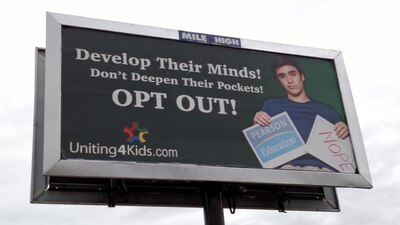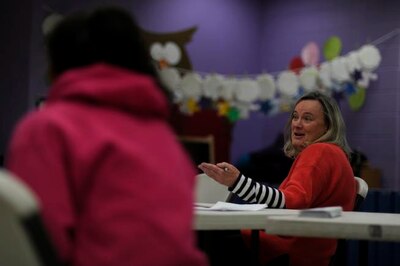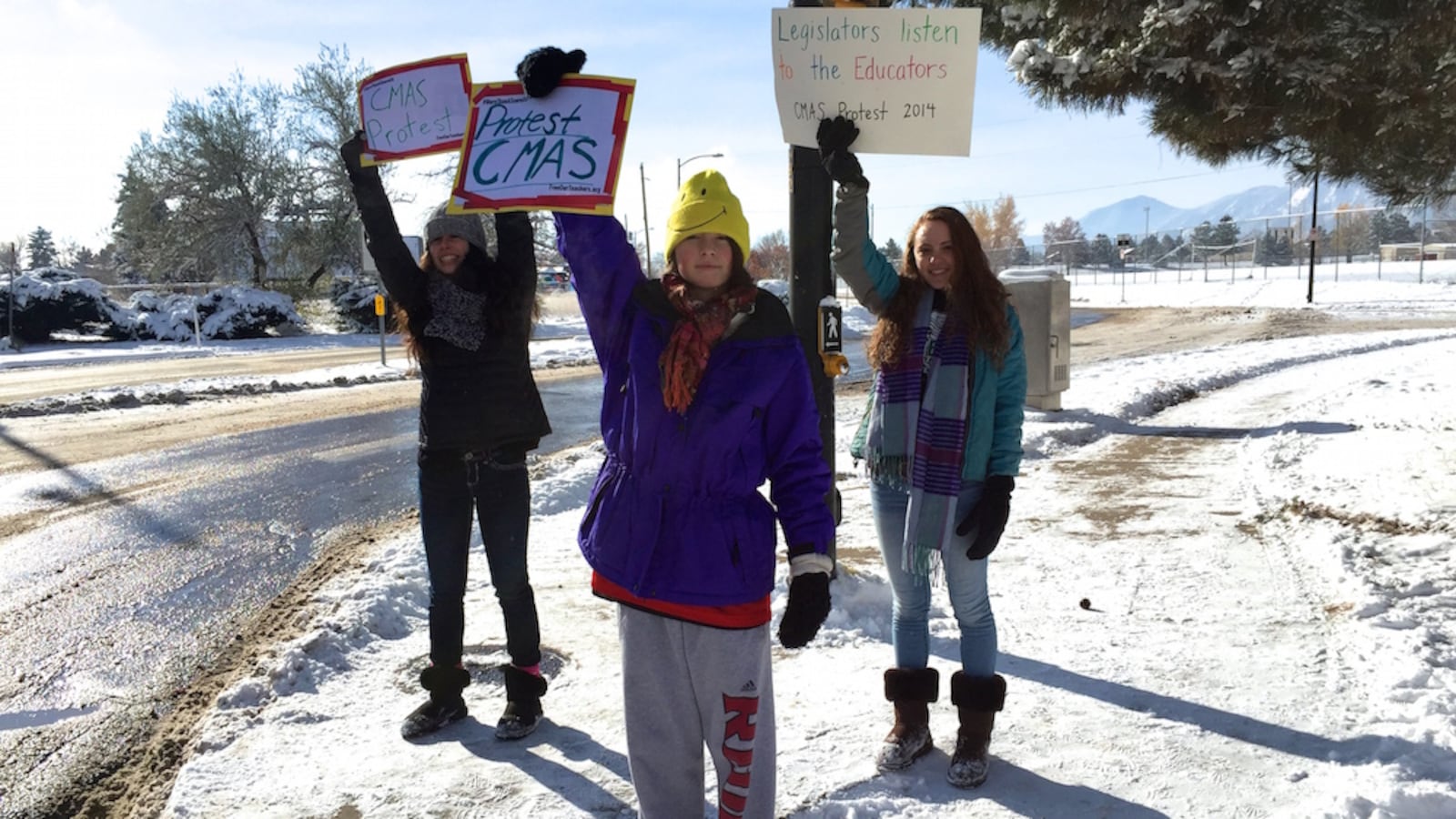A year ago, thousands of Colorado students, parents and educators fed up with state tests used to hold schools, districts and teachers accountable said enough was enough.
More than 100,000 kids in grades three through 11 did not take new tests in math and language arts designed to measure how well they stack up to state academic standards.
Only about half of the state’s 11th graders took the exams. Just one grade — third — saw participation rates hit the 95 percent threshold set as the minimum required under federal law.
Colorado had become an epicenter of the opt-out movement.
This year, things are different.
Here are five reasons opt-out organizers may have a hard time building on that momentum this testing season:
There are fewer tests, and they’re shorter.
On the very last day of the 2015 legislative session, lawmakers passed compromise legislation that pared back state assessments. Not everyone was satisfied, but the political dynamics of shared governance meant pragmatism was going to win out.
The biggest headline was the elimination of PARCC language arts and math tests in 10th and 11th grades — and the preservation of ninth grade tests at the insistence of Democratic Gov. John Hickenlooper, whose veto pen held sway over the spring.
The biggest reason why PARCC opt-out numbers will plummet this year: High school sophomores and juniors accounted for more than half — 53,000 — of the roughly 104,000 Colorado students who did not take PARCC exams last spring, according to state data.
At the same time, PARCC exams got a little shorter for the states that remain in the increasingly skeletal multi-state collective that give the online Common Core tests.
At least one Colorado opt-out activist has said the goal for this year is to grow the number of opt-outs three-fold — to 300,000.
But former teacher Angela Engel, founder and executive director of United for Kids, a volunteer-run nonprofit that focuses not just on opt-out but more broadly on equity, innovation and organizing parents, cautioned against using raw numbers as a measuring stick.
With 10th and 11th grade PARCC testing gone, Engel argues the strength of the opt-out movement is better measured in the percentage of students that opt-out this spring.
“One of my concerns is that it’ll appear that opt-out is actually on the decline, when it’s not,” she said. “What is in decline is the amount of testing.”
Two opt-out hot spots last year report things haven’t changed much so far this year. In the Boulder Valley School District, about half of ninth-graders, a quarter of middle-schoolers and one in 10 elementary school students have opted out of PARCC this spring, officials say. The Cherry Creek School District says opt-out figures there are tracking with last year’s, too.
Colorado Education Commissioner Rich Crandall told Chalkbeat earlier this spring he expects much greater participation rates on this year’s state tests.
“I think we’re in a fair place,” Crandall said of Colorado’s testing landscape. “It’s definitely not too much testing, and I think the benefits outweigh the disadvantages.”
The political noise has quieted — for now.
A year ago, backlash against Common Core standards and the debut of PARCC tests dominated headlines. As online PARCC tests arrived — and not without glitches — state lawmakers got to work.
Not only was testing reform the signature education issue of the session, it was one of the biggest issues of the session, period.
Even before the 2016 General Assembly began, lawmakers signaled they were tired of it. Consider this, from a Democrat on the Senate Education Committee:
Sure enough, attempts to further chisel away at testing have fizzled this year.
On Tuesday, a bill that would have eliminated mandatory ninth grade PARCC tests died a swift death on the Senate floor. That the measure couldn’t even clear the Republican-controlled Senate — where it stood a far better chance of passage — tells you all you need to know.
There’s another reason for Colorado’s acceptance of the status quo this year: The long-in-the-making rewrite of the nation’s primary K-12 education law gives states greater flexibility to strike out on their own when it comes to what testing looks like and how it relates to accountability.
Crandall has not been shy about wanting to put Colorado at the front of the line in seeking this flexibility. Lawmakers have expressed interest in doing the same, when the time is right.
Colorado’s break from the testing wars may end up being a one-year cease fire.
There’s little evidence — so far — the opt-out movement is getting more diverse.
You might have seen the Twitter hashtag #optoutsowhite.
That the opt-out movement’s biggest numbers lie in wealthy white suburban enclaves such as south suburban Denver and Boulder County is indisputable.
Last year in Colorado, white students were disproportionately represented in the group that did not take PARCC tests, state data shows. Across all tested grades, about 78 percent of white students took the tests, while 85 percent of black students and 88 percent of Hispanic students did. Fewer than 9 percent of those who missed the exams last spring were eligible for free and reduced lunch status — an indicator of poverty.
It’s unclear how many students skipped the tests in protest or missed them for other reasons. (The figures above were calculated using the English tests; math participation was comparable).

As Politico noted earlier this spring, the opt-out movement is working to diversify it ranks and persuade minority parents that state tests are bad for their kids.
In Colorado, a small-scale billboard campaign encouraging opt-out this spring is focused not on minority communities but rather high-population centers, said Engel, of United for Kids. Five billboard designs picturing children who are opting out — one of them an African-American girl — are on display along the Front Range.
Jennilynne Coley is a Cherry Creek School District parent who is refusing to allow her African-American son to take state tests this spring at Laredo Middle School in Aurora.
Coley said she doesn’t think the tests accurately measure his intelligence or chances of success. She believes the tests are used unfairly against teachers in evaluations and determining their pay. And she is convinced the focus on testing unduly influences classroom teaching.
I asked Coley why more parents of students of color haven’t embraced the opt-out movement.
“When you don’t understand or know how the system works, you don’t understand you do have power and you do have a voice and you can speak up,” said Coley, who is self-employed.
She went on to say that minority parents are more likely to listen to school leaders and other authority figures, and are “busy taking care of their families and trying to survive.”
At the same time, standardized testing supporters are working to shore up support in minority communities, arguing that mass opt-outs will once again obscure achievement gaps that No Child Left Behind-era testing finally brought to the surface.
The opt-out movement — and the motivations behind it — is diffuse.
If it feels hard to get your hands around the opt-out movement, you’re not imagining things.
There is no one dominant organization, no one-stop shop for information. The movement is comprised of a few volunteer-run groups with not a lot of money, and engaged parents and students who are relying primarily on word of mouth and social media to spread their message.
“It’s pretty diffuse,” said former Jefferson County school board member Paula Noonan, who has an ear to the ground on opt-out doings. “It’s generally grassroots and under the radar.”
In late February in Los Angeles, I moderated an Education Writers Association panel on the opt-out movement. To open the discussion, I posed this question to Robert Schaeffer, a longtime critic of standardized testing who is public education director of FairTest, the National Center for Fair & Open Testing:
“What is the ultimate goal of opt-out? Is it to eliminate accountability-based standardized testing altogether? To reduce the volume of testing? To uncouple tests from school accountability and teacher evaluations? All of the above?”
Schaeffer’s reply, roughly paraphrased: All of the above.
While the loose structure and a wide range of agendas can prove beneficial, it also makes growing a movement challenging.
Opt-outs rates are likely to rise in some places — in ninth grade, certain high schools and some rural districts — but not enough to offset these other factors.
Let’s be clear: The opt-out movement in Colorado is not just limping along, nor is it going anywhere. It’s hard to imagine parents who opposed testing all of a sudden last year having a change of heart.
Schools in high-performing, affluent suburban areas with high opt-out rates last year may very well top them this year.

Parents in rural districts that didn’t see much opt-out activity last year may look at what happened in other rural communities last year and join the cause.
One thing seems a safe bet: lower participation in ninth-grade PARCC exams — possibly much lower.
It’s easy to envision high school freshmen looking at their older classmates and saying, “If they don’t have to take these tests, why should I?” An underwhelming number of students taking ninth grade tests would provide more ammunition to backers of finding alternative tests for freshmen.
Reports also are trickling in of poor participation on high school science tests — these are Colorado-only tests, not part of PARCC — in some school and districts.
Noonan, the former Jeffco board member, said Colorado opt-out activists are focusing efforts on elementary schools, where testing participation is high. You can see the logic — start ’em young. But it might be prove a tough sell.
“For the most part, at the elementary level, there is still value in knowing how our students are doing,” said Norm Alerta, director of assessment and evaluation in the Cherry Creek district.
Proponents of Colorado’s academic standards and aligned tests, meanwhile, hold out hope that year one was the toughest, and that more people will buy into the tests once they get used to them and get a fuller picture of student performance.
“Going into the second year, we’re going to start to see growth data and more information because we can compare the results to previous years,” said Reilly Pharo Carter, executive director of Climb Higher Colorado, which champions the tests.
The state’s official testing window closes Friday, and a full picture of participation rates will not be available for a few months.
Absent the political rancor, tests in two critical high school grades or significant progress in growing and diversifying their ranks, anti-testing activists’ goal of building on the momentum of last year’s big opt-out numbers faces a tough test.

